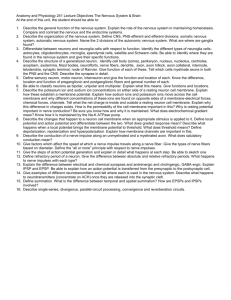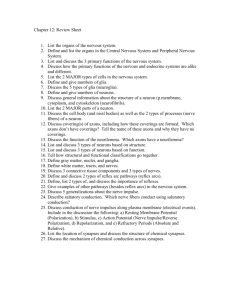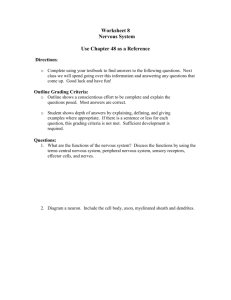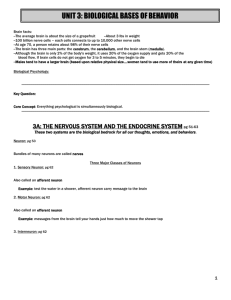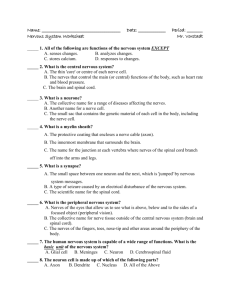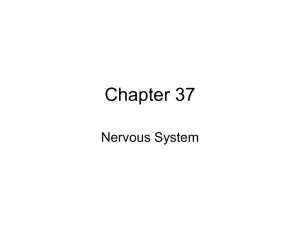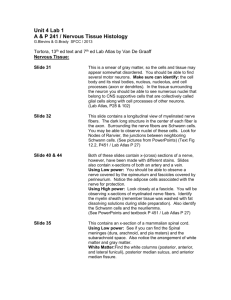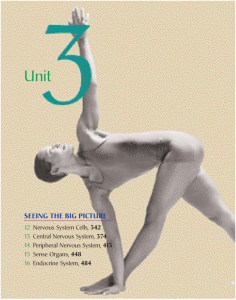Anatomy and Physiology 241 Lecture Objectives The Nervous
advertisement
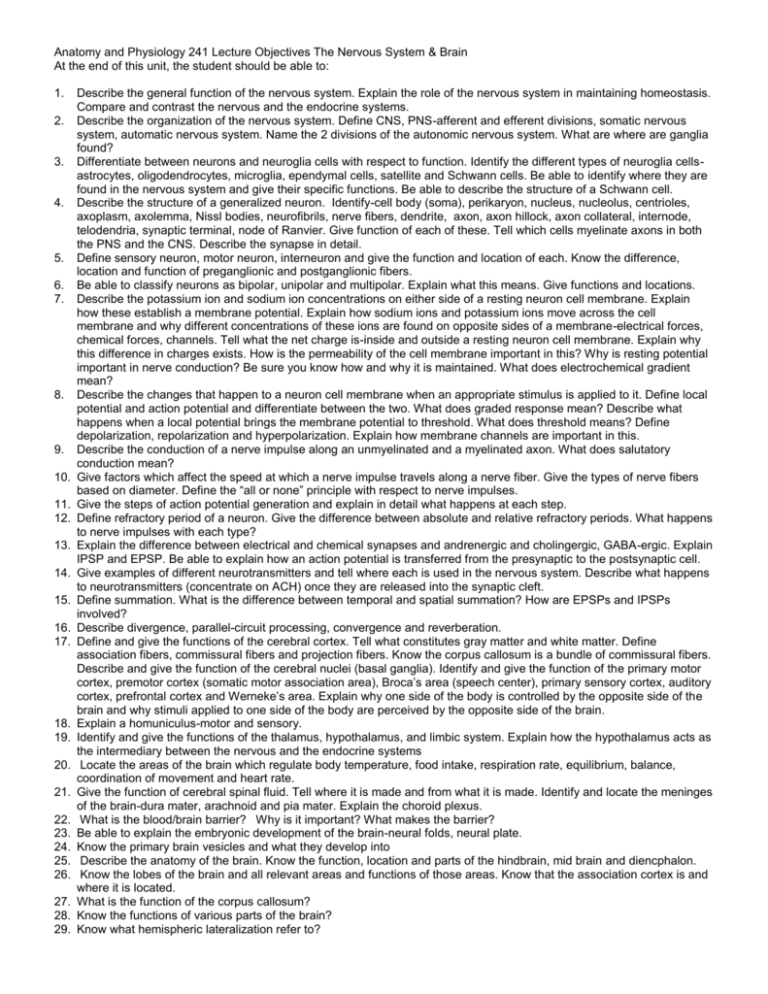
Anatomy and Physiology 241 Lecture Objectives The Nervous System & Brain At the end of this unit, the student should be able to: 1. 2. 3. 4. 5. 6. 7. 8. 9. 10. 11. 12. 13. 14. 15. 16. 17. 18. 19. 20. 21. 22. 23. 24. 25. 26. 27. 28. 29. Describe the general function of the nervous system. Explain the role of the nervous system in maintaining homeostasis. Compare and contrast the nervous and the endocrine systems. Describe the organization of the nervous system. Define CNS, PNS-afferent and efferent divisions, somatic nervous system, automatic nervous system. Name the 2 divisions of the autonomic nervous system. What are where are ganglia found? Differentiate between neurons and neuroglia cells with respect to function. Identify the different types of neuroglia cellsastrocytes, oligodendrocytes, microglia, ependymal cells, satellite and Schwann cells. Be able to identify where they are found in the nervous system and give their specific functions. Be able to describe the structure of a Schwann cell. Describe the structure of a generalized neuron. Identify-cell body (soma), perikaryon, nucleus, nucleolus, centrioles, axoplasm, axolemma, Nissl bodies, neurofibrils, nerve fibers, dendrite, axon, axon hillock, axon collateral, internode, telodendria, synaptic terminal, node of Ranvier. Give function of each of these. Tell which cells myelinate axons in both the PNS and the CNS. Describe the synapse in detail. Define sensory neuron, motor neuron, interneuron and give the function and location of each. Know the difference, location and function of preganglionic and postganglionic fibers. Be able to classify neurons as bipolar, unipolar and multipolar. Explain what this means. Give functions and locations. Describe the potassium ion and sodium ion concentrations on either side of a resting neuron cell membrane. Explain how these establish a membrane potential. Explain how sodium ions and potassium ions move across the cell membrane and why different concentrations of these ions are found on opposite sides of a membrane-electrical forces, chemical forces, channels. Tell what the net charge is-inside and outside a resting neuron cell membrane. Explain why this difference in charges exists. How is the permeability of the cell membrane important in this? Why is resting potential important in nerve conduction? Be sure you know how and why it is maintained. What does electrochemical gradient mean? Describe the changes that happen to a neuron cell membrane when an appropriate stimulus is applied to it. Define local potential and action potential and differentiate between the two. What does graded response mean? Describe what happens when a local potential brings the membrane potential to threshold. What does threshold means? Define depolarization, repolarization and hyperpolarization. Explain how membrane channels are important in this. Describe the conduction of a nerve impulse along an unmyelinated and a myelinated axon. What does salutatory conduction mean? Give factors which affect the speed at which a nerve impulse travels along a nerve fiber. Give the types of nerve fibers based on diameter. Define the “all or none” principle with respect to nerve impulses. Give the steps of action potential generation and explain in detail what happens at each step. Define refractory period of a neuron. Give the difference between absolute and relative refractory periods. What happens to nerve impulses with each type? Explain the difference between electrical and chemical synapses and andrenergic and cholingergic, GABA-ergic. Explain IPSP and EPSP. Be able to explain how an action potential is transferred from the presynaptic to the postsynaptic cell. Give examples of different neurotransmitters and tell where each is used in the nervous system. Describe what happens to neurotransmitters (concentrate on ACH) once they are released into the synaptic cleft. Define summation. What is the difference between temporal and spatial summation? How are EPSPs and IPSPs involved? Describe divergence, parallel-circuit processing, convergence and reverberation. Define and give the functions of the cerebral cortex. Tell what constitutes gray matter and white matter. Define association fibers, commissural fibers and projection fibers. Know the corpus callosum is a bundle of commissural fibers. Describe and give the function of the cerebral nuclei (basal ganglia). Identify and give the function of the primary motor cortex, premotor cortex (somatic motor association area), Broca’s area (speech center), primary sensory cortex, auditory cortex, prefrontal cortex and Werneke’s area. Explain why one side of the body is controlled by the opposite side of the brain and why stimuli applied to one side of the body are perceived by the opposite side of the brain. Explain a homuniculus-motor and sensory. Identify and give the functions of the thalamus, hypothalamus, and limbic system. Explain how the hypothalamus acts as the intermediary between the nervous and the endocrine systems Locate the areas of the brain which regulate body temperature, food intake, respiration rate, equilibrium, balance, coordination of movement and heart rate. Give the function of cerebral spinal fluid. Tell where it is made and from what it is made. Identify and locate the meninges of the brain-dura mater, arachnoid and pia mater. Explain the choroid plexus. What is the blood/brain barrier? Why is it important? What makes the barrier? Be able to explain the embryonic development of the brain-neural folds, neural plate. Know the primary brain vesicles and what they develop into Describe the anatomy of the brain. Know the function, location and parts of the hindbrain, mid brain and diencphalon. Know the lobes of the brain and all relevant areas and functions of those areas. Know that the association cortex is and where it is located. What is the function of the corpus callosum? Know the functions of various parts of the brain? Know what hemispheric lateralization refer to?
